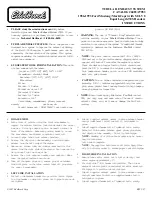
WARNING!
•
A belt that is buckled into the wrong buckle will
not protect you properly. The lap portion could ride
too high on your body, possibly causing internal
injuries. Always buckle your belt into the buckle
nearest you.
•
A belt that is too loose will not protect you prop-
erly. In a sudden stop, you could move too far
forward, increasing the possibility of injury. Wear
your seat belt snug.
•
A belt that is worn under your arm is dangerous. Your
body could strike the inside surfaces of the vehicle in
a collision, increasing head and neck injury. A belt
worn under the arm can cause internal injuries. Ribs
are not as strong as shoulder bones. Wear the belt
over your shoulder so that your strongest bones will
take the force in a collision.
(Continued)
WARNING!
(Continued)
•
A shoulder belt placed behind you will not protect
you from injury during a collision. You are more
likely to hit your head in a collision if you do not
wear your shoulder belt. The lap and shoulder belt
are meant to be used together.
4. Position the lap belt across your thighs, below your
abdomen. To remove slack in the lap belt portion, pull
up a bit on the shoulder belt. To loosen the lap belt if
it is too tight, tilt the latch plate and pull on the lap
belt. A snug belt reduces the risk of sliding under the
belt in a collision.
2
THINGS TO KNOW BEFORE STARTING YOUR VEHICLE
51
Summary of Contents for 2014 Challenger SRT
Page 1: ...O W N E R S M A N U A L 2 0 1 4 Challenger SRT ...
Page 4: ......
Page 7: ...1 INTRODUCTION 5 ...
Page 10: ......
Page 100: ......
Page 136: ...134 UNDERSTANDING THE FEATURES OF YOUR VEHICLE ...
Page 137: ...3 UNDERSTANDING THE FEATURES OF YOUR VEHICLE 135 ...
Page 138: ...136 UNDERSTANDING THE FEATURES OF YOUR VEHICLE ...
Page 204: ......
Page 209: ...INSTRUMENT CLUSTER 4 UNDERSTANDING YOUR INSTRUMENT PANEL 207 ...
Page 281: ...4 UNDERSTANDING YOUR INSTRUMENT PANEL 279 ...
Page 352: ...350 STARTING AND OPERATING ...
Page 384: ......
Page 497: ...INDEX 10 ...
















































